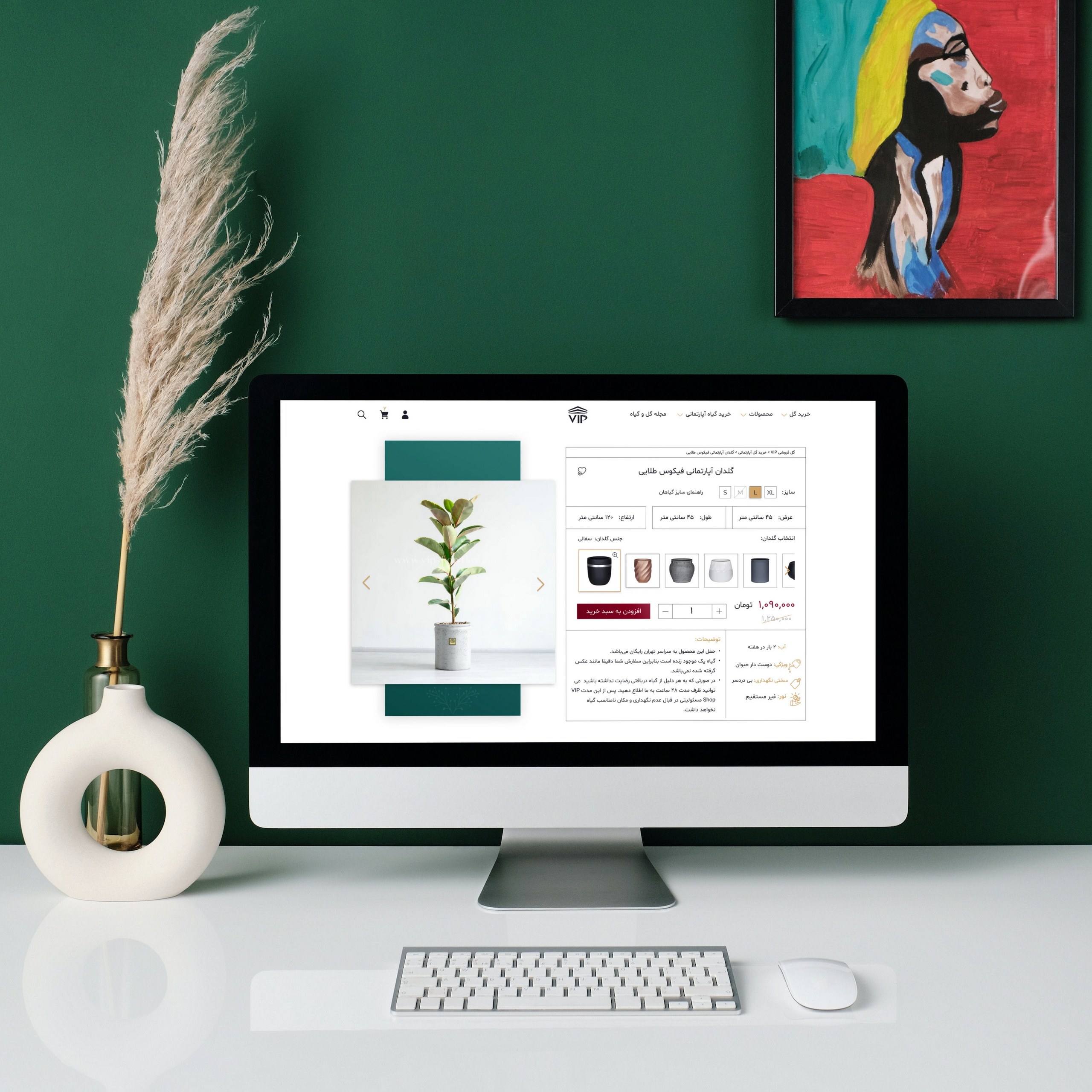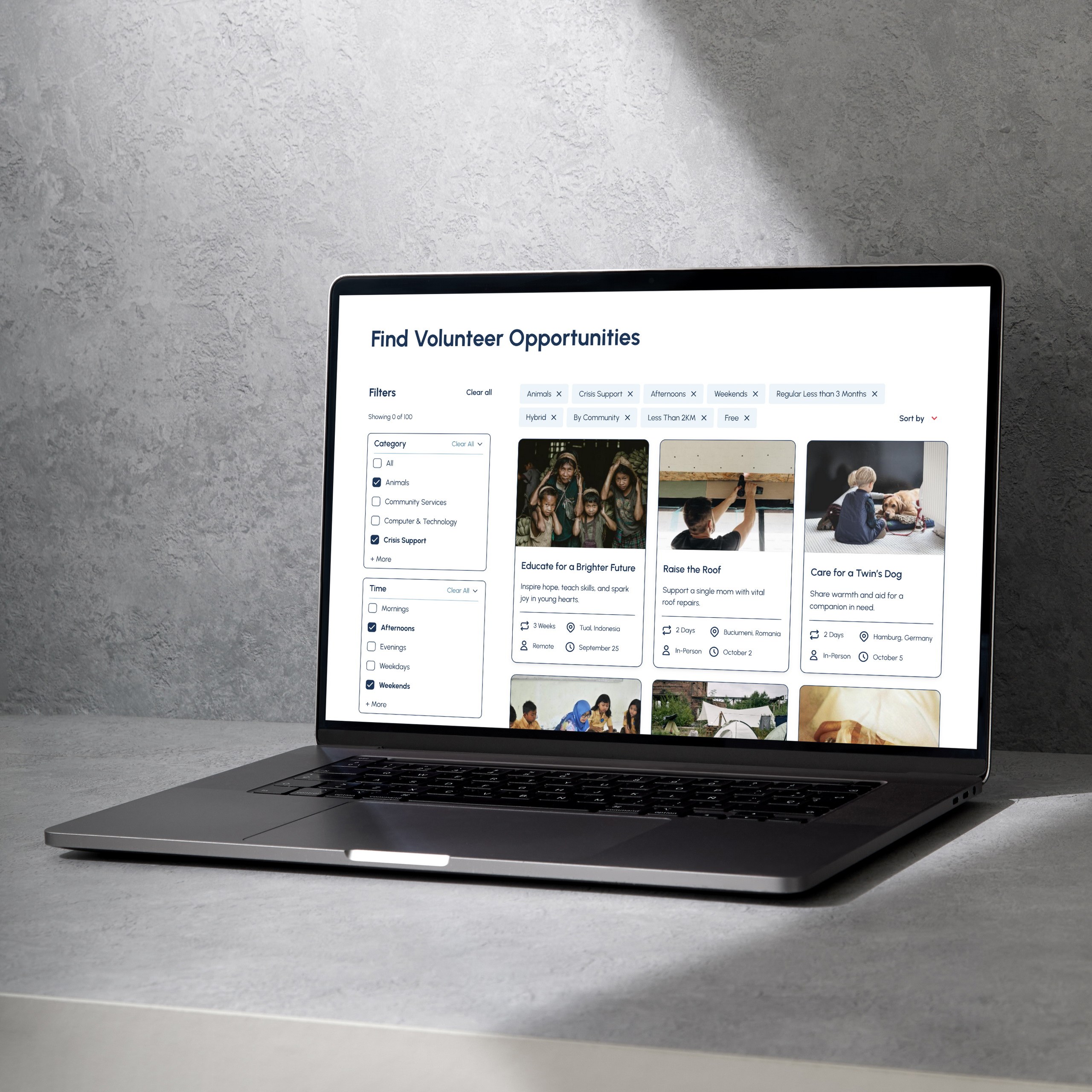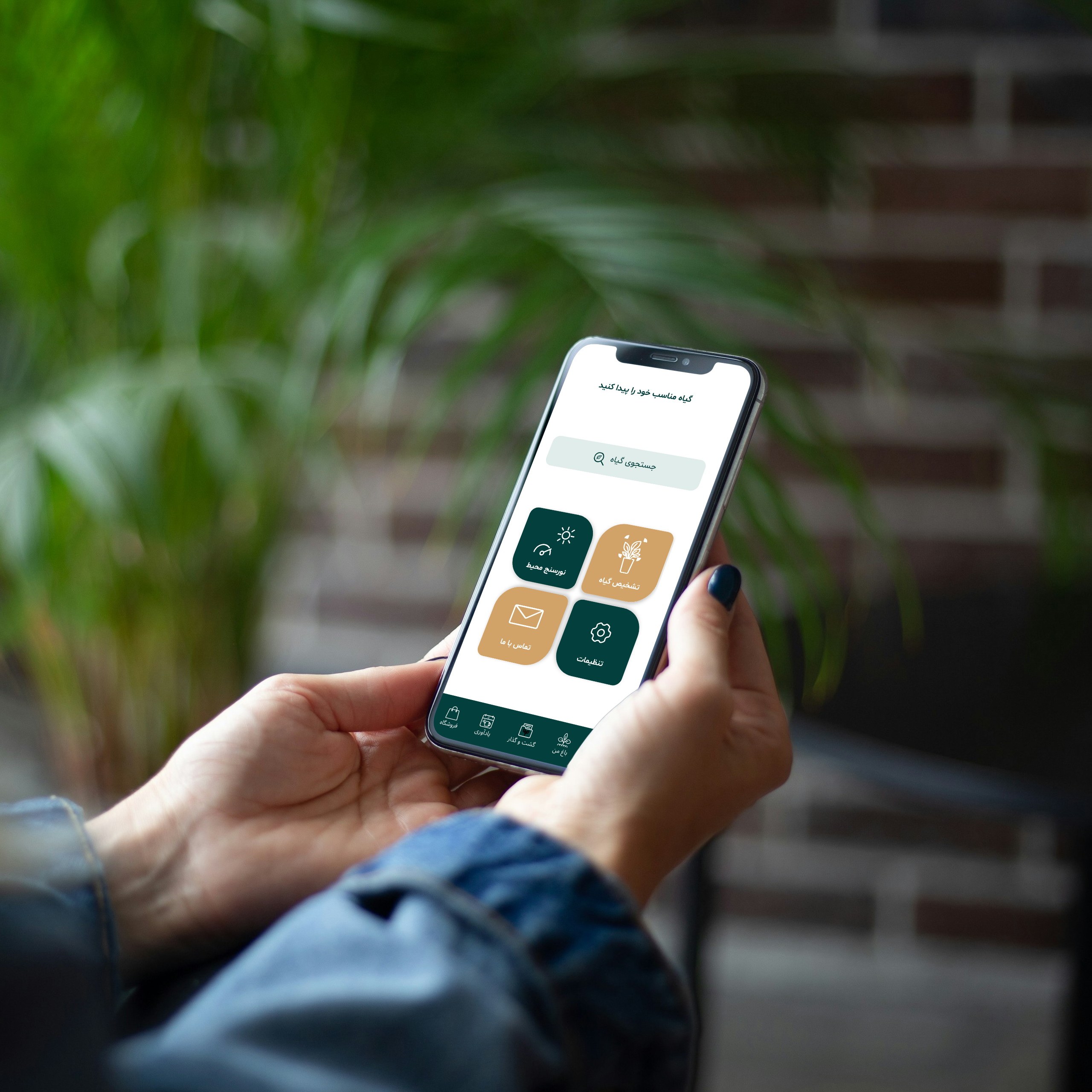Custom Pot Selection
Client
Project type
year
Role
Project Overview
At VIP Shop, I spearheaded a revamp of the plant-and-pot selection process, allowing customers to customize their purchases. By designing an intuitive interface and integrating it with our inventory system, I enabled real-time updates on stock availability and precise plant-pot matches. This overhaul improved user satisfaction and streamlined inventory management, aligning with both the needs of our customers and our operational efficiency.
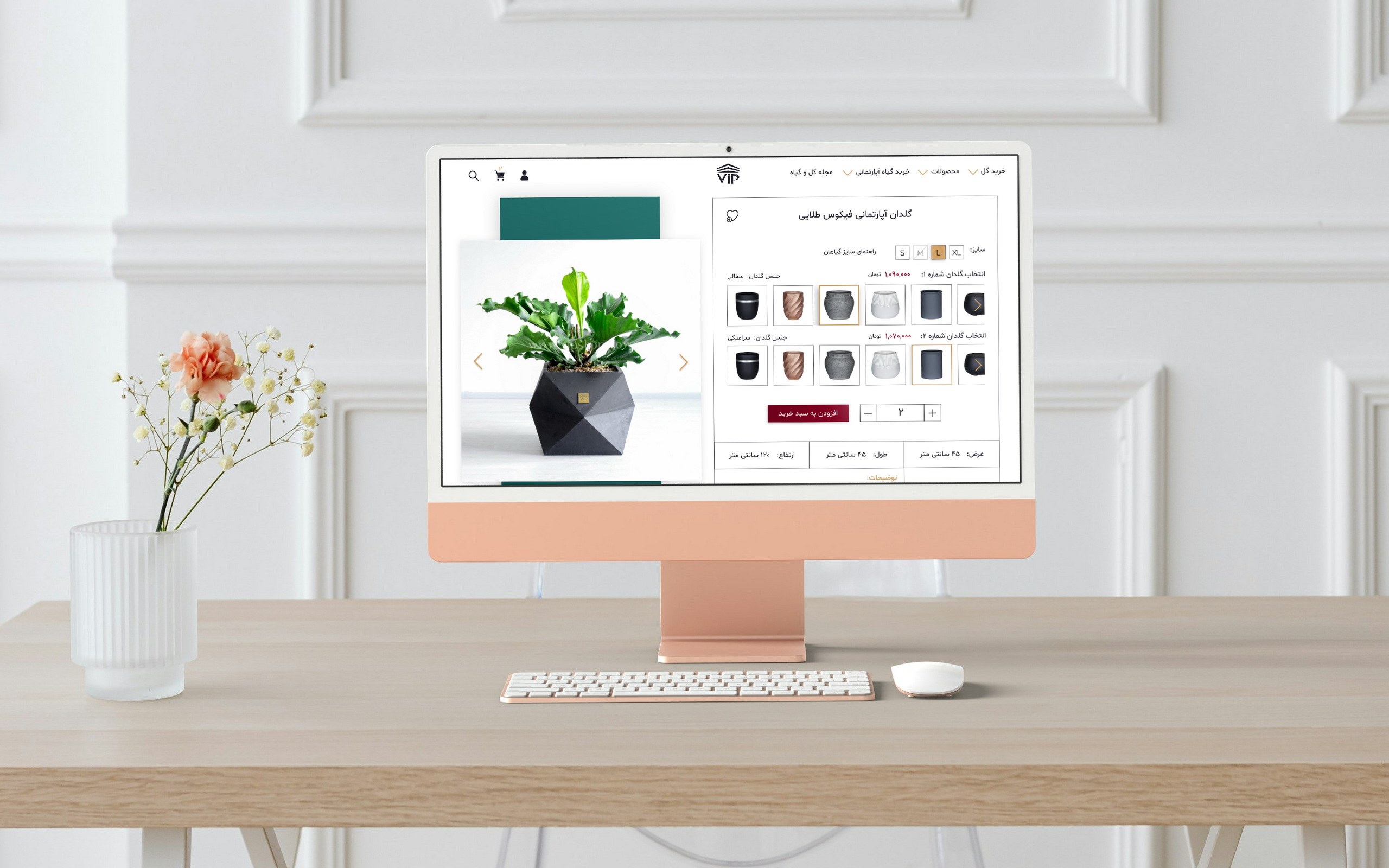
Problem Statement
The fixed plant-and-pot pairings at VIP Shop restricted customer choice, leading to a static shopping experience and inventory management challenges. This lack of personalization meant customers couldn't choose pot styles, sizes, or materials to fit their preferences, resulting in missed opportunities for engagement and sales. Recognizing these limitations, I identified the need for a customizable solution to enhance user experience, improve inventory management, and align better with customer needs.
Research & User Interviews
To deeply understand user needs and behaviors, I conducted thorough research and user interviews. Using post-purchase surveys, customer calls, and direct feedback, I gathered insights into preferences, challenges, and areas for improvement in plant-pot customization. These interactions revealed common pain points and desires for flexibility, helping shape a user-focused design approach. This research phase provided a strong foundation for developing a more personalized and seamless shopping experience.
User Persona Development
To ensure a user-centric approach in designing VIP Shop’s customizable plant-pot feature, I created detailed personas representing the key user segments. These personas provided a deep understanding of user needs, preferences, and challenges, guiding the design and functionality of the platform.
1. Plant Enthusiasts: Passionate about plant care and health, they seek functional pots that enhance plant growth while also maintaining aesthetics. Personas like Leila prioritize features like drainage, size, and material.
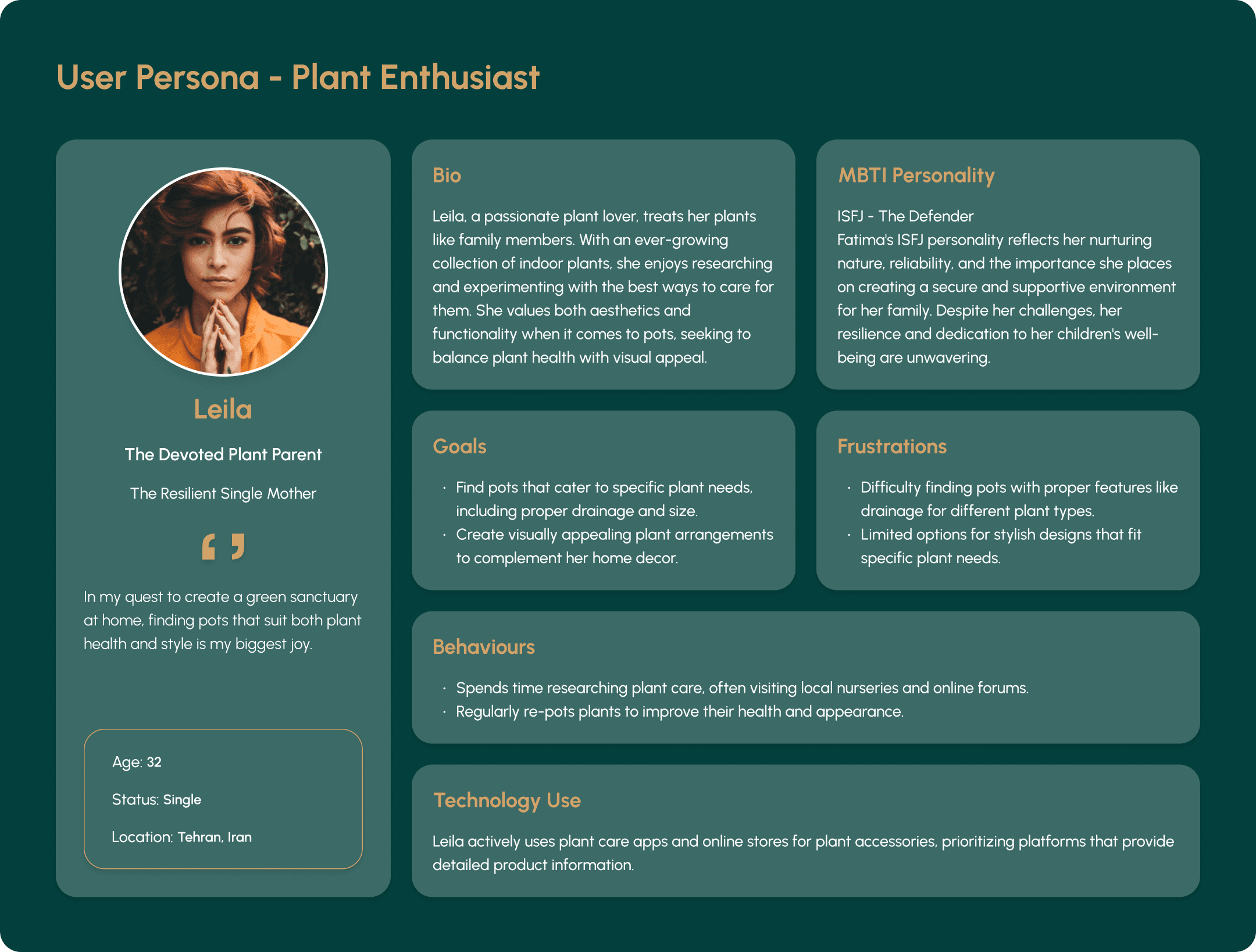
2. Style-Conscious Shoppers: Focused on aesthetics, they view plants as an element of home decor. Personas like Arman look for pots that align with their interior design style, preferring variety in materials and finishes.
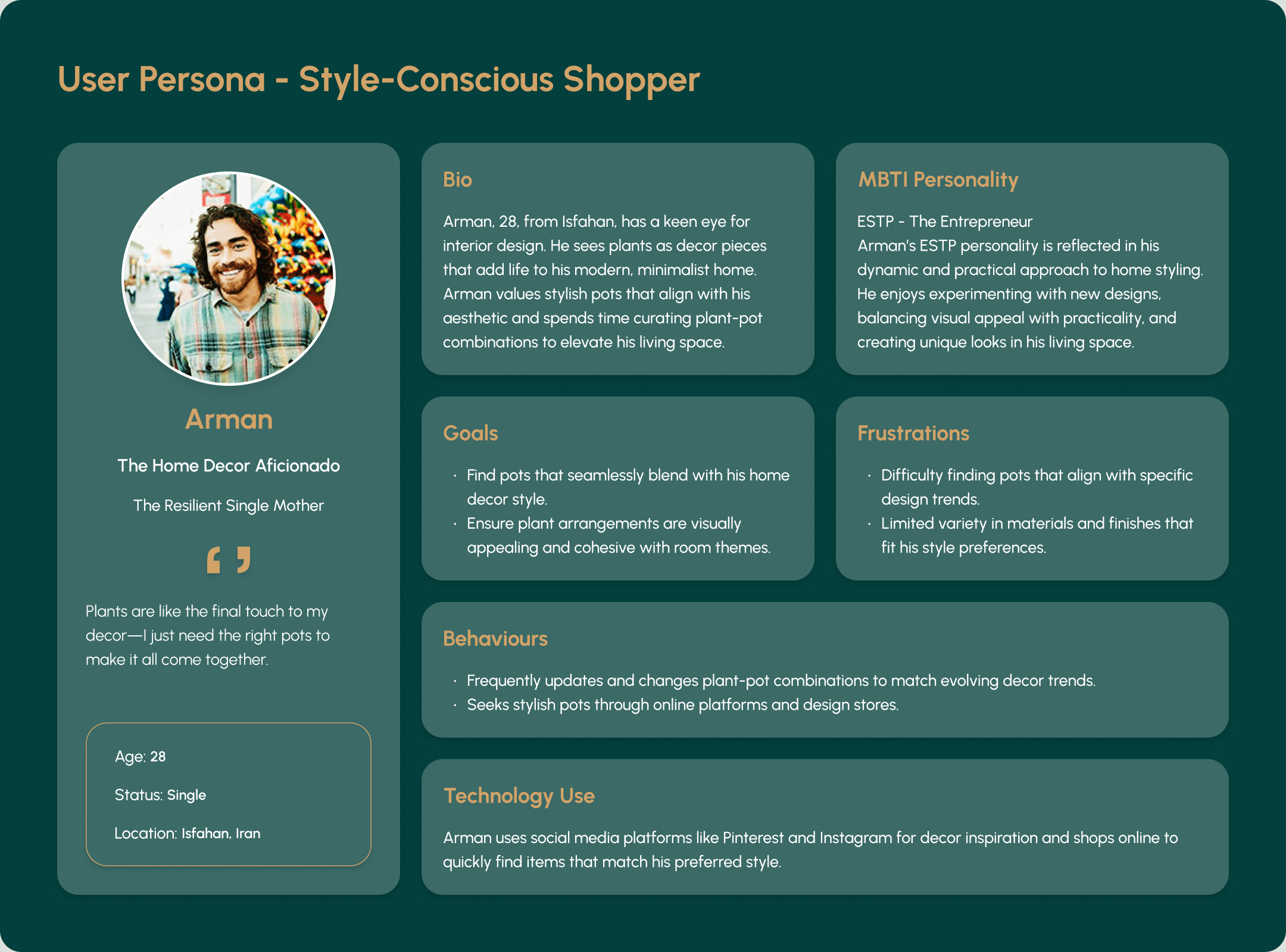
Persona Goals: These personas were created to empathize with user needs, driving decisions on pot selection, customization options, and ensuring that both plant care and style preferences were integrated seamlessly into the design.
Findings & Insights
The design execution phase at VIP Shop was centered on creating an engaging, functional solution for the customizable pot feature. Here's a breakdown of the process:
During the research phase, a series of key insights were gathered to inform the design of the customizable pot feature. Understanding user behavior, preferences, and pain points enabled me to make data-driven decisions:
Customization Desire: Users wanted control over plant-pot pairings for aesthetic and functional reasons, highlighting the need for both style and practicality.
Inventory Needs: Efficient sizing categories were necessary to ensure smooth matching of plants and pots, reducing errors and returns.
Market Gaps: Competitors lacked flexible customization, providing an opportunity for VIP Shop to lead with a personalized approach.
My Approach & Solutions
To address VIP Shop's customization challenge, I focused on creating a solution that aligned with both user needs and seamless platform integration. My goal was to enhance the shopping experience by introducing a customizable pot selection feature that fit effortlessly within the existing system. Here’s how I approached and solved this:
User Experience Design: I crafted an intuitive interface for pot selection, making sure it integrated naturally into the shopping flow. This improved user satisfaction by allowing easy personalization.
Collaboration with Technical Team: I partnered with the development team to ensure that technical feasibility and inventory system integration were prioritized. This guaranteed smooth functionality and accurate stock updates.
Creating a Sizing System: To prevent mismatched plant and pot sizes, I developed a sizing framework that linked pot dimensions to plant categories, ensuring each pairing was both aesthetic and practical. This step was essential in driving customer satisfaction.
Curating Diverse Pot Designs: I selected an array of pot styles, balancing function and style to meet different tastes. Offering a diverse range of options encouraged customers to find combinations that suited their preferences.
Establishing Feedback Channels for Iteration: After launch, I set up feedback systems to collect customer responses, allowing continuous iteration and improvement of the feature. This agile approach ensured the customization feature remained responsive to user needs.
By integrating these solutions, the customizable pot selection feature transformed the VIP Shop experience, offering flexibility to users while maintaining operational efficiency.
Decision Making
Based on research findings and insights, I made key decisions to shape the customizable pot selection feature effectively:
Customization Focus: Prioritized the ability for users to select pots based on their style and functional needs.
Sizing Framework: Developed a structured system for plant and pot sizes to ensure perfect matches, reducing mismatches and return rates.
Design Priorities: Ensured the interface was intuitive, aligned with user personas, and followed VIP Shop’s brand aesthetics for a cohesive experience.
Wireframing & User Journey Mapping
The wireframing phase focused on mapping out the user experience for the new customizable feature:
Wireframes & Layout: Created wireframes for key pages of the selection process, ensuring easy navigation and a logical flow.
User Journey Mapping: Outlined each step of the user's interaction, from product selection to checkout, to guarantee an intuitive and smooth experience.
Feedback & Iteration: Gathered feedback on early wireframes to refine and enhance usability before moving to visual design.

Design Execution
I translated wireframes into high-fidelity designs, ensuring visual appeal and seamless functionality:
Visual Consistency: Maintained the brand's aesthetics with a coherent color palette, typography, and UI elements.
User-Centric Elements: Prioritized intuitive design for easy pot selection and plant customization.
Collaborative Development: Worked closely with developers for smooth feature integration, tackling any technical issues.
Design System Development
I created a design system to ensure consistency across all user interactions:
Style Guide: Defined color palettes, typography, and UI components to align with VIP Shop’s branding.
Reusable Components: Developed a library of reusable design elements, such as buttons and modals, for a cohesive user interface.
Scalability: Built the system to be flexible, accommodating future feature additions while maintaining a uniform look and feel.
Prototyping and Testing
During the prototyping and testing phase, I transformed the design concept for VIP Shop's customizable pot feature into a tangible, interactive prototype. This step was critical to validate the design and gather user feedback. Here's how I approached it:
Building the Prototype: I developed a clickable prototype that simulated the new feature. This prototype allowed users to interact with the customizable pot selection as if it were live on the website.
User Testing Sessions: I organized user testing sessions, inviting a diverse group of participants to try the prototype. Observing their interactions and listening to their feedback was crucial for identifying any usability issues.
Feedback Analysis: After each testing session, I analyzed the feedback, identifying common trends, user pain points, and areas of delight. This helped in pinpointing what worked well and what needed improvement.
Iterative Improvements: Based on the insights gained from user testing, I iteratively refined the prototype. This involved tweaking the design, adjusting user flows, and resolving any technical glitches.
Stakeholder Review: I presented the revised prototype to stakeholders at VIP Shop for final input, ensuring it aligned with business objectives and met user needs effectively.
Design Iterations
The design process underwent multiple refinements to ensure optimal functionality and user experience:
Iterative Wireframe Updates: Adjusted wireframes after each testing round to improve clarity and flow.
User Journey Adjustments: Redesigned touchpoints to streamline navigation from selection to checkout.
Enhanced Visual Hierarchy: Improved the prominence of essential features like customization options to ensure clarity.
Stakeholder Feedback: Incorporated business insights to align with VIP Shop’s operational goals.
Accessibility Improvements: Tweaked elements for better accessibility, ensuring an inclusive experience.
Usability Testing: Continued testing with revised designs for ongoing feedback.
Final Evaluation & User Testing
After multiple iterations, the final design was thoroughly evaluated:
Comprehensive User Testing: Conducted multiple rounds of testing with different user personas to ensure the design met diverse needs.
Performance Checks: Verified smooth performance of the customizable pot feature, ensuring it aligned with VIP Shop’s operational goals.
Feedback Collection & Analysis: Gathered detailed feedback to ensure the final product was intuitive, visually appealing, and highly functional.
Stakeholder Sign-Off: Received approval from stakeholders after presenting the refined design and testing results.
Final Solution
After thorough prototyping and iterative testing, I finalized and launched the customizable pot feature for VIP Shop. This final solution was a culmination of extensive research, user feedback, and careful design. Here’s an overview of the final implementation:
Feature Integration: The customizable pot feature was fully integrated into VIP Shop’s online platform, allowing customers to easily choose their preferred pot for each plant.
User Interface: The final user interface was refined for optimal ease of use, with clear visuals and intuitive navigation. It allowed customers to effortlessly browse and select pots that matched their style and the plant's size.
Inventory Sync: The feature was seamlessly synced with our inventory system, ensuring real-time updates on pot availability and sizes.
Aesthetic Cohesion: The range of pots offered was carefully curated to align with VIP Shop’s brand aesthetics, ensuring each option added value to the overall visual appeal of the product.
Launch and Promotion: Upon launch, the feature was promoted through VIP Shop’s marketing channels to inform and attract customers to the new, personalized shopping experience.
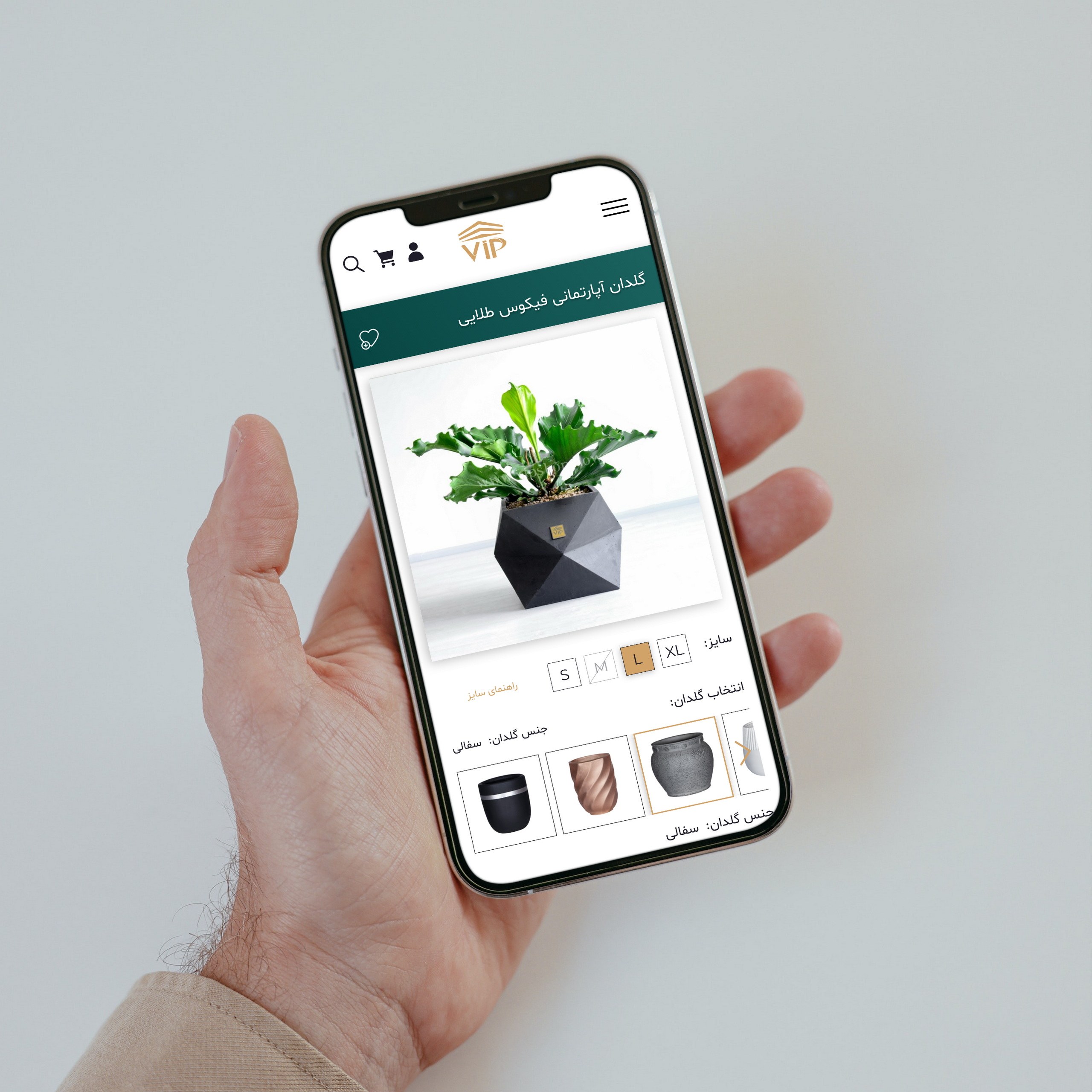
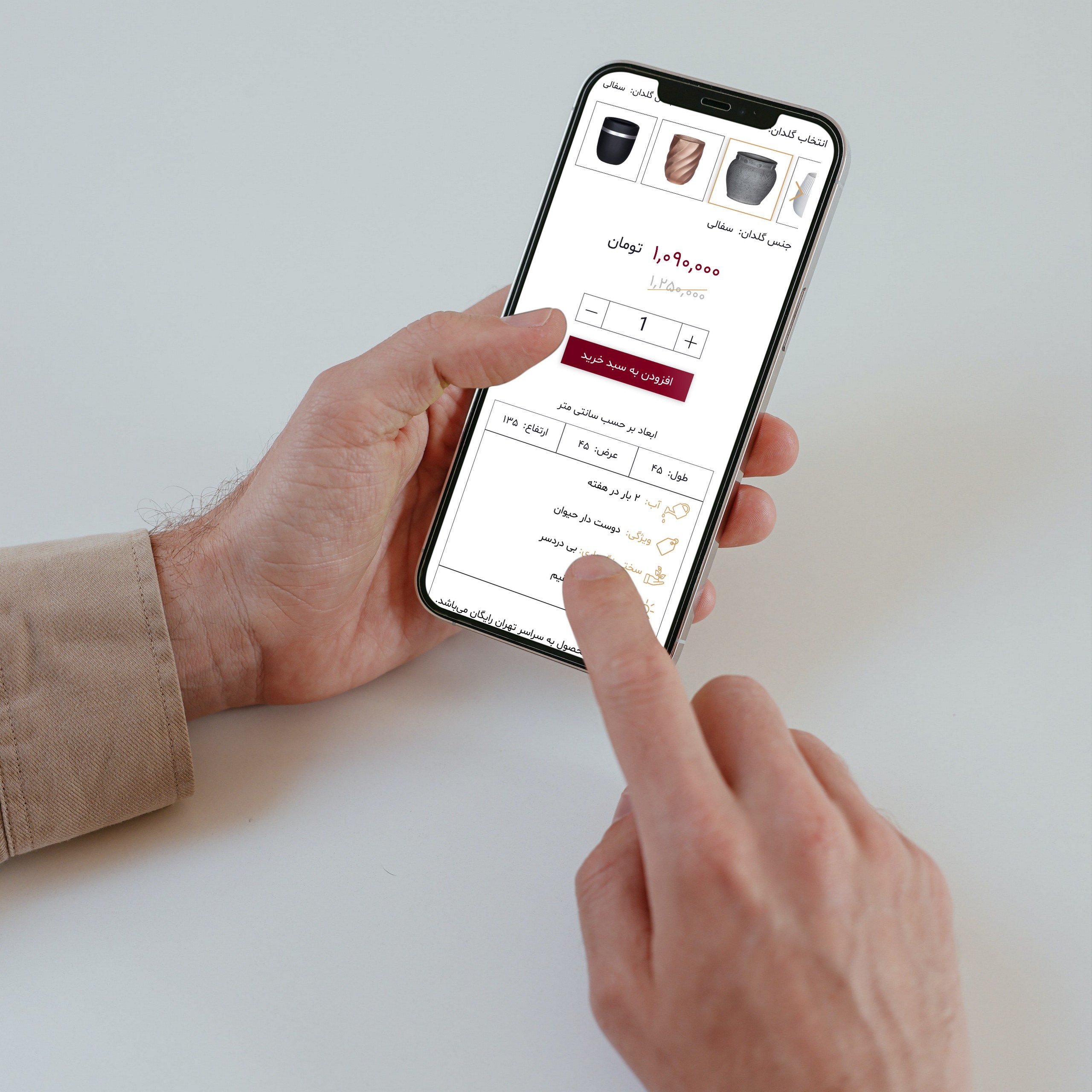
Impact
The introduction of customizable pots at VIP Shop catalyzed a remarkable transformation, evidenced by three key metrics:
Sales Growth: Our sales saw an invigorating 22% increase, a testament to customers embracing the ability to personalize their purchases.
Inventory Optimization: We achieved a significant 17% reduction in inventory, reflecting a more efficient use of resources and a better understanding of consumer demand.
Customer Satisfaction: Perhaps most rewarding was the notable 28% uplift in customer satisfaction, underscoring the alignment between our innovation and our customers' desires.
This trio of achievements—sales growth, inventory optimization, and enhanced customer satisfaction—exemplifies our commitment to not just meet, but exceed customer expectations, while also steering our business towards more sustainable practices. The numbers tell a story of success, but behind each percentage is a customer's smile, a moment of delight in finding the perfect pot for their green companion, and the silent acknowledgment of a choice well made—a narrative that fuels our passion for service excellence at VIP Shop.
Key Performance Indicators (KPIs)
To track the success of the customizable pot feature, I focused on these KPIs:
Sales Performance: Monitored the increase in sales related to customized plant-pot combinations.
Inventory Efficiency: Tracked reductions in inventory holding costs and improved stock turnover rates.
Customer Engagement: Measured customer satisfaction through post-purchase surveys, tracking overall experience and the impact of personalization.
Conversion Rate: Assessed the percentage of users who utilized the customization feature and completed purchases.
Learnings
The journey to successfully implement the customizable pot feature at VIP Shop was as enlightening as it was rewarding. Here are the key learnings from this experience:
Customer-Centric Innovation: The project reinforced the value of placing customer needs at the forefront of innovation. Personalization is not just a trend; it's a pathway to deeper customer relationships.
Agile Response to Feedback: Rapid iteration based on user feedback was instrumental in refining the feature. This agile approach to design and implementation is crucial for meeting and exceeding customer expectations.
Cross-Functional Collaboration: Working closely with different teams highlighted the importance of cross-functional collaboration. The synergy between design, tech, and inventory management was key to the feature's success.
Data-Driven Decisions: The role of data in guiding design choices and business strategies was crystal clear. Data not only informed the feature development but also helped in measuring its impact post-launch.
Sustainability in Business: The reduction in inventory underscored the potential for sustainable practices within e-commerce. By aligning business growth with environmental consciousness, we create a win-win scenario.
These insights have been instrumental in shaping my approach to product design and will continue to influence how I navigate future projects at VIP Shop and beyond.
Next Steps
Building on the success of the customizable pot feature, VIP Shop's next steps include:
Expand Customization: Broaden the variety of pot styles and plant pairings based on ongoing customer feedback.
Enhance Personalization: Implement AI-based recommendations for pot selections tailored to individual preferences.
Sustainable Practices: Continue optimizing inventory for sustainability, reducing waste, and supporting eco-friendly business practices.
Community Engagement: Strengthen customer feedback loops through surveys and social media to continually refine and improve the platform.
I'm looking forward to applying the insights from this project to future initiatives, continuing to deliver thoughtful and sustainable solutions for our customers.
More projects
Contact Me
